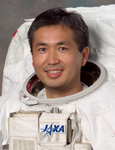|
|||||
| << ISS Astronaut Activity Report, March 2004 | June >> |
This is JAXA's primary activity report on Japanese astronauts from April to May 2004.
Astronauts Furukawa, Hoshide, and Yamazaki received the latter half of the second Soyuz training at Gagarin Cosmonaut Training Center (GCTC) in Russia from April to May. The purpose of the training was to qualify them as Flight Engineers for the Soyuz spacecraft. The first training was conducted from July to September 2003, and the first part of the second training was conducted from January to March 2004.
During the training, they received instruction related to the attitude control system and Extravehicular Activity (EVA). Training for EVA was conducted in the pool while they were wearing space suits. The astronauts also had training related to the telemetry system, Russian language, and physical exercise.
Training for the motion control system included lectures and training using the simulator. The astronauts were tested on the motion control operation during the rendezvous and docking with the ISS and during the return flight to Earth from the ISS.
The three astronauts received underwater training at the Hydro Laboratory training facility for EVA while wearing Russian Orlan space suits especially designed for EVA.Using the underwater ISS Russian segment mockup (a full-scale mockup), they simulated the mission procedures from leaving the airlock, conducting the EVA and returning to the ISS. The astronauts were able to master this basic procedure of the EVA. During training, they were constantly monitored with an electrocardiogram and were checked for pulse, respiration rate, and body temperature to see the physical reactions to the procedures and if they could think ahead to conduct operations effectively.
All three astronauts completed the Soyuz training needed to qualify as Flight Engineers of the Soyuz spacecraft.
 |
| Astronaut Wakata |
Astronaut Wakata received three weeks of training on Canadarm2 (Space Station Remote Manipulator System (SSRMS)) beginning April 13 at the Canada Space Agency and qualified as an operator.
Astronaut Wakata, who has been working as a robotics instructor astronaut for the NASA Astronaut Office, also participated in instructing and assessing the robotic arm operation. This was one of the required skills for him to finish this training curriculum.
In addition to his experience operating the Space Shuttle Remote Manipulator System (SRMS) for retrieving satellites of Japan and NASA, during the STS-72 mission and the ISS assembly during the STS-92 mission, the completion of this course now qualifies him as an operator of the three robotic arms. All three arms, the Japanese Experiment Module "Kibo" Remote Manipulator System, Canadarm2, and the SRMS are related to the ISS program. Astronaut Wakata also participated in the tele-operation experiments of Engineering Test Satellite VII (ETS-VII) Mounted Robotic Arm in 1999, conducted at Tsukuba Space Center.
Astronaut Wakata is currently a member of the NASA Astronaut Office, where he is engaged in technical operation including the development and operation of the robotic arm and extravehicular activity. His main emphasis is on development tests for the return to flight of the Space Shuttle.
The first JAXA town meeting (a rally to discuss space including the general public) was held on May 29 at Miyakonojou City in Miyazaki Prefecture. This first town meeting was a rally held to raise public interest in space activities by having an open exchange of opinions between Japanese citizens and JAXA.
 |
| Astronaut Doi and Mr. Matogawa participating in the rally |
The town meeting, titled "Citizen Participation on Space," attracted over 170 participants who exchanged opinions with Astronaut Doi and Mr. Yasunori Matogawa, an Associate Executive Director of the JAXA Public Affairs Office.
During the rally, astronaut Doi spoke of his space activities. He received questions and comments regarding the current space developments and human space flight. The citizens became more interested and excited about the space program as the rally proceeded.
Due to a lack of time, Astronaut Doi and Mr. Matogawa couldn't answer all the questions asked. JAXA is now hoping to seek a way toward future space development using the numerous opinions and survey results obtained from the general public.
Astronaut Doi hosted a talk show during the opening event of the "International Symposium on Space Technology and Science" held at Phoenix Seagaia Resort in Miyazaki. The venue for the talk show, a convention hall, was nearly filled by the 800 attendees.
 |
| Astronaut Doi presenting a prize to a winner |
Dressed in a blue suit, Astronaut Doi, elaborated on his own extravehicular activities and activities on Space Shuttle STS-87, showing videos and photographs. During the Q and A session that followed, he answered each question one by one, especially those asked by the children. One question was, "What should we study to become an astronaut?" Astronaut Doi explained that the most important thing is to be enthusiastic about going to space. He added that not only scientists and doctors but also teachers and artists would have the privilege of going to space in the future.
There was a lottery drawing after the talk show, and astronaut Doi presented an H-2A rocket model and other prizes to the lucky winners.
| << ISS Astronaut Activity Report, March 2004 | June >> |

|